An illustration showing what the planet 55 Cancri E could look like, based on current understanding of the planet. 55 Cancri is a rocky planet roughly twice the diameter of Earth and orbiting just 0.015 AU from its sun-like star. Because of its narrow orbit, the planet is extremely hot, with temperatures throughout the day reaching 4,400 degrees Fahrenheit (about 2,400 degrees Celsius). Spectroscopic observations using the Webb’s near-infrared camera (NIRCam) and mid-infrared instrument (MIRI) will help determine whether or not the planet has an atmosphere, and if so, what that atmosphere is made of. The observations will also help determine whether or not the planet is gradually shutting down. Credit: NASA, ESA, CSA, Danny Player (STScI)
Astronomers will train a high-resolution Webb spectrometer on two interesting rocky exoplanets.
Imagine if the Earth was much closer to the sun. So close that an entire year would only last a few hours. So close that gravity has locked one hemisphere into scorching daylight and the other into eternal darkness. So close that the oceans boil away, the rocks begin to melt, and lava is raining down clouds.
While there is nothing like this in our solar system, planets like this—rocky, about the size of Earth, extremely hot, and close to their stars—are not uncommon in our solar system.[{” attribute=””>Milky Way galaxy.
What are the surfaces and atmospheres of these planets really like? NASA’s James Webb Space Telescope is about to provide some answers.

Illustration showing what exoplanet LHS 3844 b could look like, based on current understanding of the planet.
LHS 3844 b is a rocky planet with a diameter 1.3 times that of Earth orbiting 0.006 astronomical units from its cool red dwarf star. The planet is hot, with dayside temperatures calculated to be greater than 1,000 degrees Fahrenheit (greater than about 525 degrees Celsius). Observations of the planet’s thermal emission spectrum using Webb’s Mid-Infrared Instrument (MIRI) will provide more evidence to help determine what the surface is made of. Credit: NASA, ESA, CSA, Dani Player (STScI)
Geology from 50 Light-Years: Webb Gets Ready to Study Rocky Worlds
With its mirror segments beautifully aligned and its scientific instruments undergoing calibration, NASA’s James Webb Space Telescope (Webb) is just weeks away from full operation. Soon after the first observations are revealed this summer, Webb’s in-depth science will begin.
Included in the investigations planned for the first year are studies of two hot exoplanets classified as “super-Earths” for their size and rocky composition: the lava-covered 55 Cancri e and the airless LHS 3844 b. Scientists will train Webb’s high-precision spectrographs on these planets with a view to understanding the geologic diversity of planets across the galaxy, as well as the evolution of rocky planets like Earth.
Super-Hot Super-Earth 55 Cancri e
55 Cancri e orbits less than 1.5 million miles from its Sun-like star (one twenty-fifth of the distance between Mercury and the Sun), completing one circuit in less than 18 hours. With surface temperatures far above the melting point of typical rock-forming minerals, the day side of the planet is thought to be covered in oceans of lava.

Illustration comparing rocky exoplanets LHS 3844 b and 55 Cancri e to Earth and Neptune. Both 55 Cancri e and LHS 3844 b are between Earth and Neptune in terms of size and mass, but they are more similar to Earth in terms of composition.
The planets are arranged from left to right in order of increasing radius.
Image of Earth from the Deep Space Climate Observatory: Earth is a warm, rocky planet with a solid surface, water oceans, and a dynamic atmosphere.
Illustration of LHS 3844 b: LHS 3844 b is a hot, rocky exoplanet with a solid, rocky surface. The planet is too hot for oceans to exist and does not appear to have any significant atmosphere.
Illustration of 55 Cancri e: 55 Cancri e is a rocky exoplanet whose dayside temperature is high enough for the surface to be molten. The planet may or may not have an atmosphere.
Image of Neptune from Voyager 2: Neptune is a cold ice giant with a thick, dense atmosphere.
The illustration shows the planets to scale in terms of radius, but not location in space or distance from their stars. While Earth and Neptune orbit the Sun, LHS 3844 b orbits a small, cool red dwarf star about 49 light-years from Earth, and 55 Cancri e orbits a Sun-like star roughly 41 light-years away. Both are extremely close to their stars, completing one orbit in less than a single Earth day.
Credit: NASA, ESA, CSA, Dani Player (STScI)
Planets that orbit this close to their star are assumed to be tidally locked, with one side facing the star at all times. As a result, the hottest spot on the planet should be the one that faces the star most directly, and the amount of heat coming from the day side should not change much over time.
But this doesn’t seem to be the case. Observations of 55 Cancri e from NASA’s Spitzer Space Telescope suggest that the hottest region is offset from the part that faces the star most directly, while the total amount of heat detected from the day side does vary.
Does 55 Cancri e Have a Thick Atmosphere?
One explanation for these observations is that the planet has a dynamic atmosphere that moves heat around. “55 Cancri e could have a thick atmosphere dominated by oxygen or nitrogen,” explained Renyu Hu of NASA’s Jet Propulsion Laboratory in Southern California, who leads a team that will use Webb’s Near-Infrared Camera (NIRCam) and Mid-Infrared Instrument (MIRI) to capture the thermal emission spectrum of the day side of the planet. “If it has an atmosphere, [Webb] It has the sensitivity and wavelength range to detect and identify its components.”
Or is it raining lava in the evening on 55 Cancri E?
However, another interesting possibility is that the 55 Cancri e is not bezel-locked. Alternatively, it might be like Mercury, rotating three times per two orbits (what is known as a 3:2 resonance). As a result, the planet will have a day and night cycle.
“This may explain why the hotter part of the planet is turning,” explained Alexis Brandecker, a researcher from Stockholm University who leads another team studying the planet. “Just like on Earth, it will take time for the surface to heat up. The hottest time of the day will be in the afternoon, not noon.”

The heat potential emission spectrum of the super-Earth hot exoplanet LHS 3844 b, as measured by Webb’s Mid-Infrared Instrument. The thermal emission spectrum shows the amount of light of different infrared wavelengths (colours) emitted by the planet. Researchers use computer models to predict what a planet’s heat emission spectrum will look like assuming certain conditions, such as whether or not there is an atmosphere and what the planet’s surface is made of.
This particular simulation assumes that LHS 3844 b has no atmosphere and that the day side is covered in dark igneous igneous rocks. (Basalt is the most common igneous rock in our solar system, making up volcanic islands like Hawaii and most of Earth’s ocean floor, as well as large portions of the surfaces of the Moon and Mars.)
For comparison, the gray line represents a typical spectrum of basaltic rocks based on laboratory measurements. The pink line is the spectrum of granite, the most common igneous rock found on Earth’s continents. These two types of rocks have very different spectra because they are made of different minerals that absorb and emit different amounts of different wavelengths of light.
After Webb spots the planet, the researchers will compare the actual model spectra of different types of rocks like this one to see what the planet’s surface is made of.
Source: NASA, ESA, CSA, Dani Player (STScI), Laura Kreidberg (MPI-A), Renyu Hu (NASA-JPL)
Brandeker’s team plans to test this hypothesis using NIRCam to measure the heat emitted from the illuminated side of 55 Cancri e through four different orbits. If a planet had a 3:2 echo, they would observe each hemisphere twice and should be able to detect any difference between the two hemispheres.
In this scenario, the surface would heat up, melt, and even evaporate during the day, forming an extremely thin atmosphere that Webb could detect. In the evening, the steam cools and condenses to form drops of lava that will rain back to the surface, turning solid again as night falls.
Somewhat cooler Super Earth LHS 3844 b
While 55 Cancri e will provide insight into the strange geology of a lava-covered world, LHS 3844 B Provides a unique opportunity to analyze hard rocks on[{” attribute=””>exoplanet surface.
Like 55 Cancri e, LHS 3844 b orbits extremely close to its star, completing one revolution in 11 hours. However, because its star is relatively small and cool, the planet is not hot enough for the surface to be molten. Additionally, Spitzer observations indicate that the planet is very unlikely to have a substantial atmosphere.
What Is the Surface of LHS 3844 b Made of?
While we won’t be able to image the surface of LHS 3844 b directly with Webb, the lack of an obscuring atmosphere makes it possible to study the surface with spectroscopy.
“It turns out that different types of rock have different spectra,” explained Laura Kreidberg at the Max Planck Institute for Astronomy. “You can see with your eyes that granite is lighter in color than basalt. There are similar differences in the infrared light that rocks give off.”
Kreidberg’s team will use MIRI to capture the thermal emission spectrum of the day side of LHS 3844 b, and then compare it to spectra of known rocks, like basalt and granite, to determine its composition. If the planet is volcanically active, the spectrum could also reveal the presence of trace amounts of volcanic gases.
The importance of these observations goes far beyond just two of the more than 5,000 confirmed exoplanets in the galaxy. “They will give us fantastic new perspectives on Earth-like planets in general, helping us learn what the early Earth might have been like when it was hot like these planets are today,” said Kreidberg.
These observations of 55 Cancri e and LHS 3844 b will be conducted as part of Webb’s Cycle 1 General Observers program. General Observers programs were competitively selected using a dual-anonymous review system, the same system used to allocate time on Hubble.
The James Webb Space Telescope is the world’s premier space science observatory. Webb will solve mysteries in our solar system, look beyond to distant worlds around other stars, and probe the mysterious structures and origins of our universe and our place in it. Webb is an international program led by NASA with its partners, ESA (European Space Agency) and the Canadian Space Agency.

“Twitter practitioner. Beer evangelist. Freelance gamer. Introvert. Bacon aficionado. Webaholic.”











More Stories
A long solar flare just erupted from the sun. watching video.
Mastodon’s fang reveals migration patterns in North America
Gaia probe reveals stellar DNA and unexpected ‘stellar earthquakes’ | space